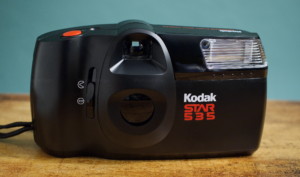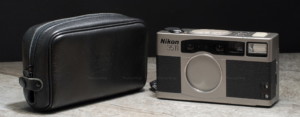
The Contax Tix was a super expensive "boutique" APS film camera that came out around 1997. I doubt there were many, (or any other) APS cameras that were more expensive than this one. Based on the hang tag of 120,000; street cost would have probably been about $999. A premium 35mm camera would've cost about the same amount, like this one.
The presentation case for the Contax Tix is so nice you would think it contained the Hope diamond. Rich people bought this camera for vacation snaps when it first came out. Starting around 2000 and later, digital cameras started taking a serious bite out of the film business , and the price dropped enough so middle class folks could afford a very nice sub-compact film camera. Unfortunately, a few years later, the film would no longer be made, and you wound up with a nice paper weight for your desk. It's too bad because the Contax Tix is very small and convenient, with a lot of premium features and a really sharp Carl Zeiss Sonnar lens.
The Contax Tix is a sub-compact film camera, and uses APS film which has not been manufactured since around 2010-11...






